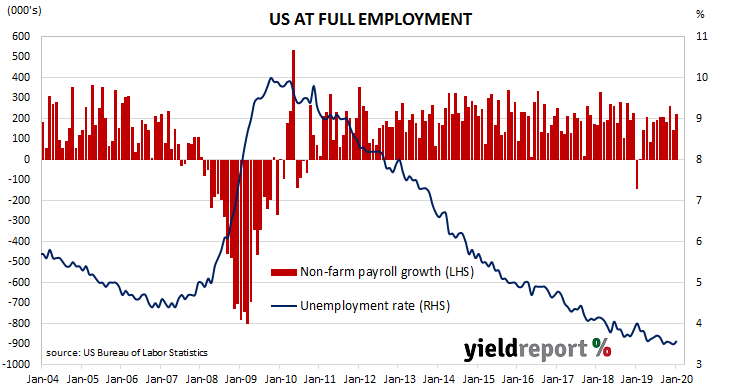The US economy continues to produce more jobs despite being close to full employment. The unemployment rate has remained at or under 4% since April 2018 and the underemployment rate has been falling in trend terms. The latest employment report indicates the US economy is still producing jobs and drawing Americans back into the workforce.
According to the US Bureau of Labor Statistics, the US economy created an additional 225,000 jobs in the non-farm sector in January, more than December’s revised increase of 147,000 and more than the 160,000 increase which had been expected. Employment figures for December and November were revised up by a total of 7,000.
January’s unemployment rate ticked up from December’s rate of 3.5% to 3.6%. The total number of unemployed increased by 139,000 to 5.892 million while the total number of people who are either employed or looking for work increased by 50,000 to 164.606 million. The increase in the number of people in the labour force helped drive the participation rate from 63.2% to 63.4%.
NAB economist Tapas Strickland described the result as “strong” but noted the report “had little impact on markets, suggesting the coronavirus was the predominant force on markets.” US Treasury yields fell uniformly across the curve. By the close of business, 2-year, 10-year and 30-year Treasury yields had all lost 6bps to 1.40%, 1.58% and 2.05% respectively.
US Treasury yields fell uniformly across the curve. By the close of business, 2-year, 10-year and 30-year Treasury yields had all lost 6bps to 1.40%, 1.58% and 2.05% respectively.
In terms of likely US monetary policy, according to federal funds futures contracts the probability of a rate cut in the first half of 2020 remained small, although price changes did imply some small increases. The implied likelihood of a 25bps cut at the March meeting of the FOMC increased from 9% to 11% while a Fed move in June rose from 36% to 46%. A Fed cut in July looked more likely as prices at the end of the day implied traders had increased the chances of a rate cut in that month from 49% to 57%.

